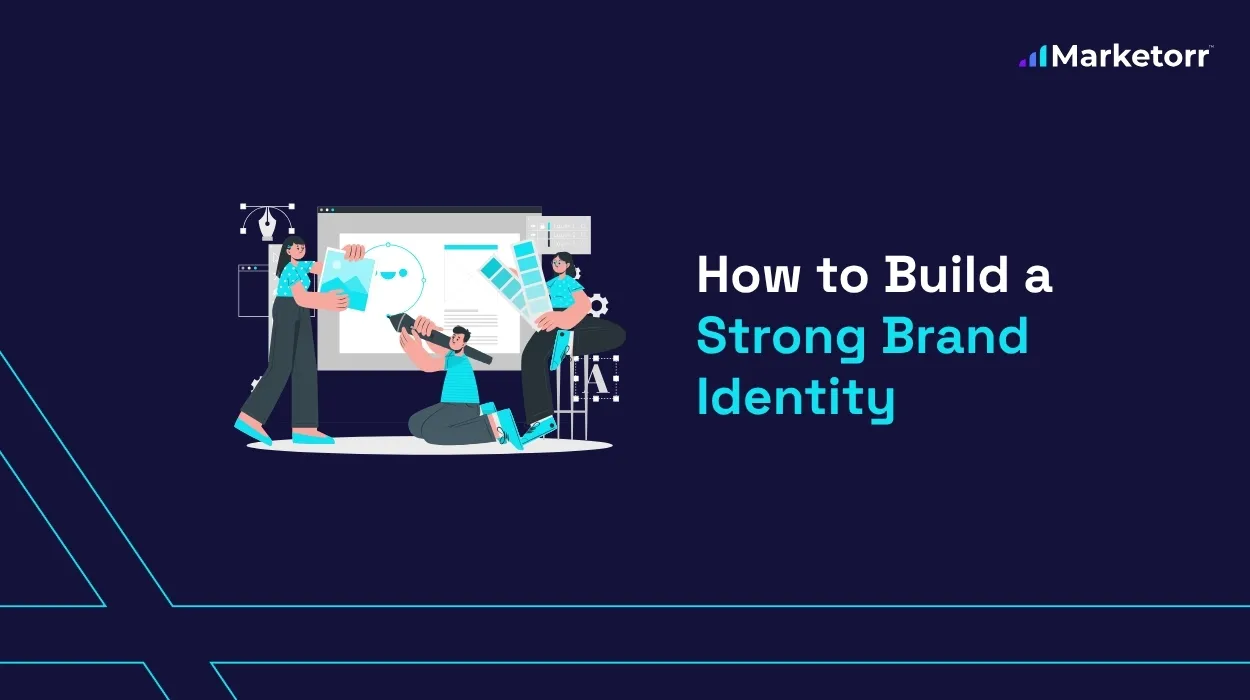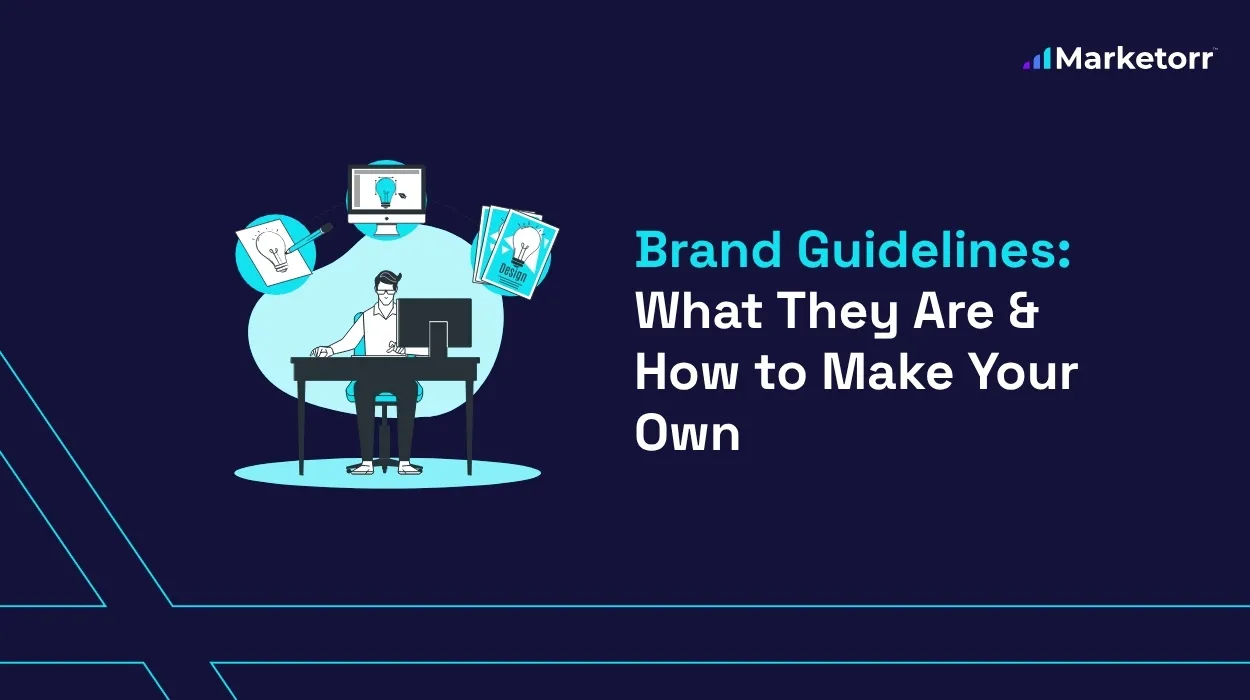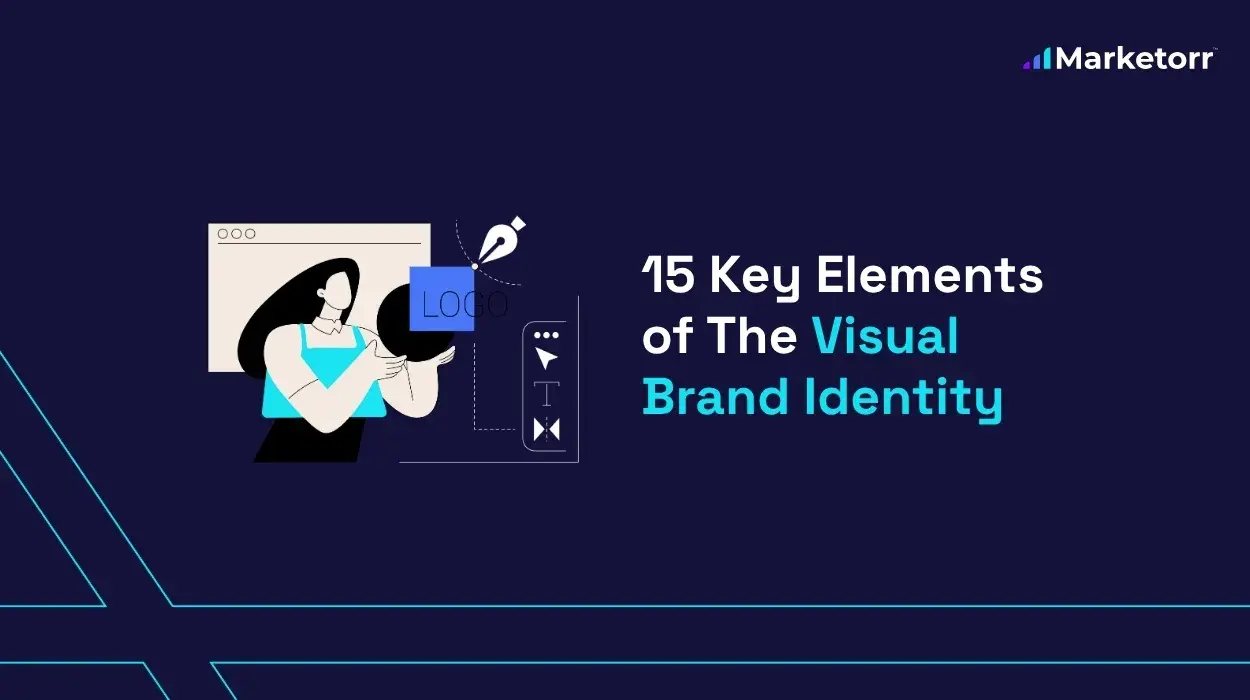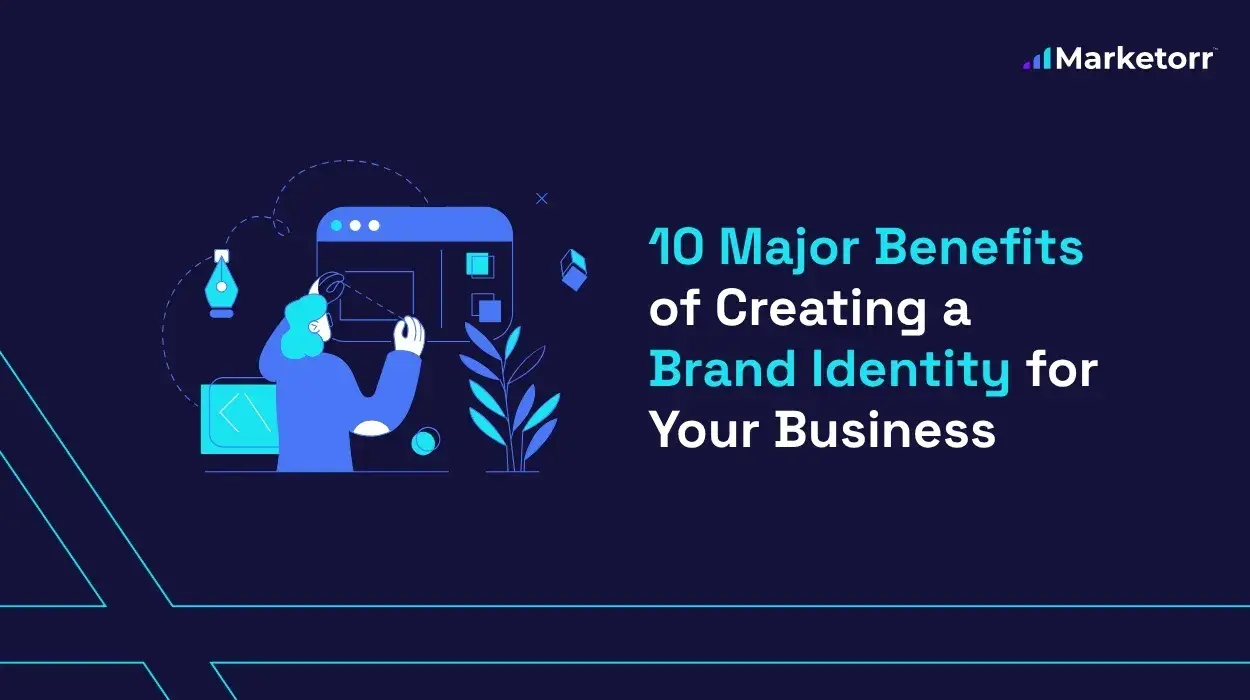Brand identity shapes how a business is recognized, trusted, and remembered. As of 2025, brands with consistent identities across platforms see up to 23% higher revenue, while 82% of consumers prefer to buy from companies that reflect their personal values.
In saturated markets, identity is not just a design concern but a competitive advantage. From visuals and tone to purpose and positioning, every element influences how people perceive a brand and decide whether to engage.
Strong brand identities not only improve recognition but also increase customer loyalty, resilience during crises, and long-term business growth.
Key Elements of a Powerful Brand Identity
A strong brand identity isn’t just about looking good. It’s how people remember you, trust you, and decide whether they feel connected to your brand.
Your brand identity is made up of a few main parts, how it looks, how it sounds, what it stands for, and the feeling it gives off. These pieces need to work together if you want people to recognize and believe in your brand. When it all lines up, it builds trust and makes your business easier to remember.
Let’s talk about the pieces that matter most.
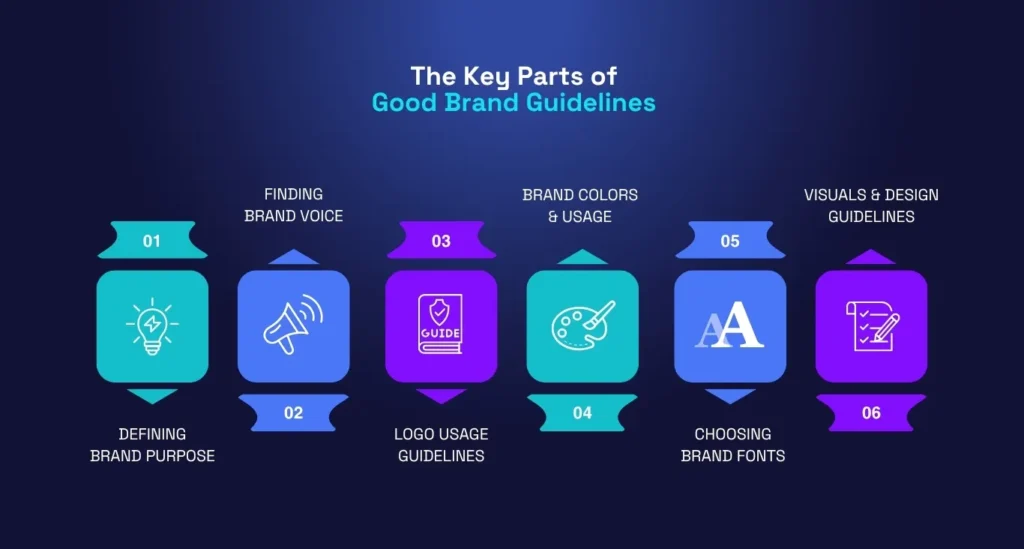
Your logo and visual style
The logo is usually the first thing people notice. It doesn’t need to be fancy or complicated and it just needs to stick. Simple and clean tends to work best, especially when it has to look good in different places, like on your website, product packaging, or even an app icon.
Colors and fonts matter too, more than people think. Colors trigger emotions. Blue often feels trustworthy. Red grabs attention.
Green is calm or eco-friendly. Studies from Loyola University Maryland show that color alone can boost brand recognition by nearly 80%. That’s huge.
Typography plays a part, too. The type of font you use says a lot without saying anything. Some fonts feel serious and traditional, while others feel new, playful, or even a little rebellious.
The key is to choose styles that match the mood you want your brand to give off and then keep them consistent everywhere.
Your voice and tone
Now let’s shift from how you look to how you sound. Your brand voice is the way your business talks. Are you more casual and friendly? Or formal and expert-like? Either one can work. It just depends on who you’re trying to talk to.
Tone can change a bit depending on where you are (you might be more relaxed on Instagram and more straight-to-the-point in a whitepaper), but the overall voice should stay the same. That consistency makes your brand feel familiar, and people trust what feels familiar.
Your values and what you stand for
This part goes deeper than visuals or messaging. What does your brand actually believe in? Why do you exist beyond just making money?
People care about this stuff more than ever. A lot of customers want to buy from brands that care about something meaningful, whether it’s sustainability, community, innovation, or something else entirely.
If your brand stands for something clear and real, it creates a stronger emotional connection. It helps people feel like they’re part of something bigger when they buy from you.
How do you stand out
One last key piece: what makes you different? Your brand identity should make it obvious why someone should choose you instead of someone else.
That could be the style you use, the way you talk, the values you promote, or the story behind what you sell.
A good brand identity helps answer the question, “Why you?” without needing a long explanation. And the clearer your answer, the easier it is for people to remember you.
Brand Identity vs. Brand Image vs. Branding: What’s the Difference?
People throw around terms like brand identity, brand image, and branding all the time, sometimes like they mean the same thing. But truth is, they’re not. They’re connected, yes, but each one plays a different role in how your business shows up and how people remember it.

Let’s break it down in simple terms.
Brand identity is basically what you create. It’s the stuff you design and define, your logo, your colors, the tone of your voice, even your brand values.
It’s your chance to say, “This is who we are and what we stand for.” You control it. It’s the version of your brand you want the world to see.
Now, brand image? That’s not really up to you. That’s how people actually see you. It’s what they think and feel based on their real experiences with your brand, your website, your service, your social posts, how your product performs, all of it.
You might want to come off as sleek and reliable, but if your product breaks or your customer support is slow? People will see something totally different.
And then we’ve got branding, which is the process. It’s the day-in, day-out work of keeping your identity and your image aligned. Everything you do, from how your team talks to customers to the font on your packaging, feeds into it.
Here’s a quick side-by-side to make it more straightforward:
| Term | What It Really Means | Who Controls It | What It Affects |
| Brand Identity | The visuals, tone, personality, and values you choose to show | You (the business) | How you want to be perceived |
| Brand Image | How people actually perceive your brand based on experience | Your audience | Your reputation and emotional connection |
| Branding | The work you do to create and manage both identity and image | You (through action) | Long-term trust and customer loyalty |
How to Build Your Brand Identity Step-by-Step
Building your brand identity is all about showing people who you are and what you stand for. It’s how your business looks, sounds, and feels to the outside world. You start by getting clear on your values, your mission, and who you’re trying to reach. Then you create things like your logo, colors, and tone of voice to match that vision.
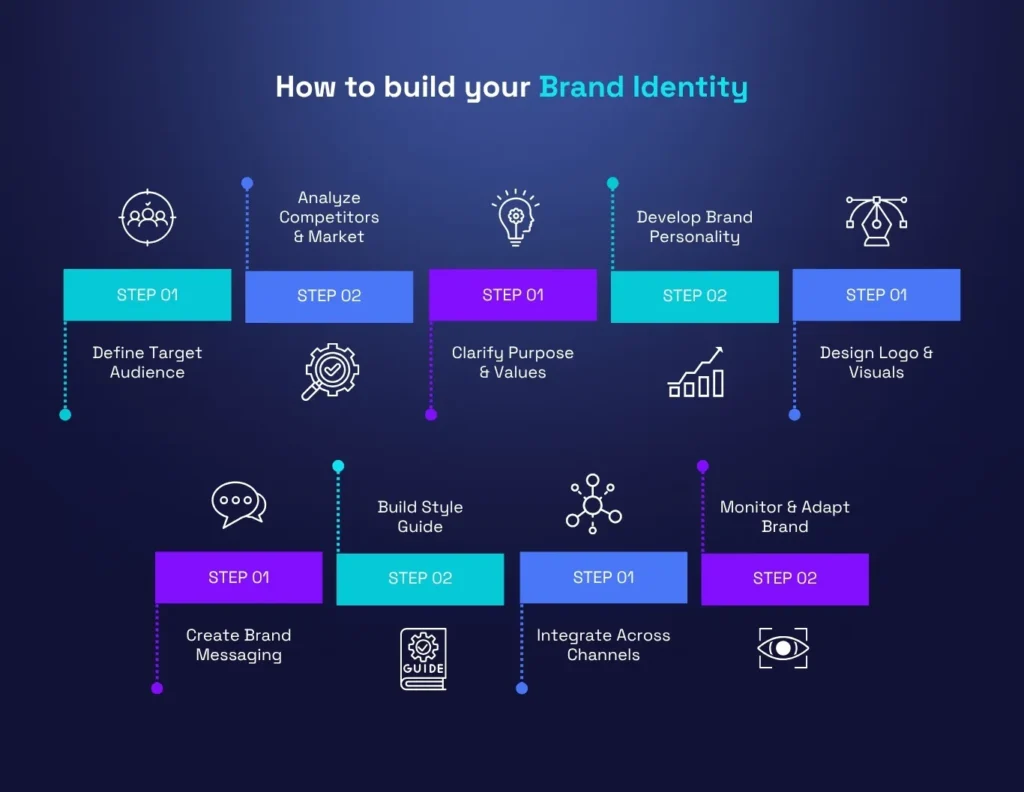
Let’s explore the steps.
Step 1: Understand and Define Your Target Audience
A brand only works when it connects with the right people. This step is about identifying who those people are and what they care about.
Start by asking, Who are you trying to reach? That includes not just basic demographics like age, gender, and location, but also behavior, values, pain points, and lifestyle.
If you’re a wellness brand, your audience may value balance, self-care, and ethical products. If you’re a tech startup, maybe they care about speed, efficiency, and innovation.
To make this clear, create audience personas. These are fictional profiles based on real data, like “James, a 34-year-old freelancer who values speed and great customer service.” The goal isn’t just to know your customer and understand what matters to them.
What problems are they trying to solve? What do they want to feel when they buy?
The better you understand your audience, the easier it becomes to shape a brand identity they’ll remember and trust. In 2025, when personalization and customer connection are everything, this is the foundation your brand must stand on.
Step 2: Analyze Competitors and Market Landscape
Before building your identity, you need to know what’s already out there. This step helps you position your brand in a unique and meaningful way.
Look at your direct competitors. What do their brand visuals look like? How do they speak to customers? What tone do they use on their websites, ads, or social media? Pay attention to what works and what feels overused.
Then go deeper. Identify gaps in the market. Maybe every company in your niche is formal and serious, but your audience might respond better to something more friendly and approachable. Or maybe no one is clearly leading with a value your audience cares about, like sustainability or speed.
This isn’t about copying competitors, it’s about doing what they’re not doing well. Your goal is to stand out with a distinct brand personality while staying relevant to the expectations of your industry.
Knowing the landscape also helps you avoid branding mistakes. If your logo, voice, or values feel too similar to a major player, it can confuse or weaken your position. Instead, find your own space in the market and build your identity around that.
Step 3: Clarify Your Brand’s Purpose, Values, and Positioning
Your brand isn’t just what you sell. It’s why you exist and what you stand for. Determining this helps you create a brand identity that’s not only attractive but meaningful.
Start with your brand purpose. Why does your business exist beyond making money? What problem are you solving or what impact are you trying to make? Maybe you want to empower creators, improve people’s health, or make tech more human.
Then define your core values. These are the principles that guide how your brand behaves. Are you focused on transparency? Innovation? Inclusivity? Your values will shape your tone, visual choices, and how people feel about your brand over time.
Lastly, nail down your positioning. This is your brand’s place in the market. What do you offer that others don’t? And why should people care? This could be about your price point, your quality, your service, or even your brand experience.
Brands that lead with purpose and values are more likely to earn loyalty. Studies show that 77% of consumers buy from brands that share their values, and 64% would switch to a brand that aligns better with what they believe in.
When your brand’s purpose is clear, people don’t buy from you but believe in you.
Step 4: Develop Your Brand Personality and Voice
Your brand needs a personality, just like a real person. This is how people emotionally connect with your business and how they remember you.
Think of your brand as a character. Is it bold and confident? Calm and helpful? Quirky and fun? Choose 3–5 traits that represent how you want to come across. These will guide your brand’s tone, look, and behavior across every channel.
Once you’ve got your personality traits, translate them into a clear brand voice. This is the tone and style of your writing and messaging. A youthful brand might sound playful and casual, while a luxury brand may speak in refined, elegant language.
Your voice should be consistent everywhere on your website, in emails, on social media, and even in customer service replies. It builds trust and helps customers know what to expect. Over time, a distinct voice becomes a signature part of your brand.
For example, Mailchimp uses a friendly, witty tone that matches their playful design style. It makes their software feel less intimidating, which appeals to small businesses who want simplicity. That alignment between voice and visual style makes the brand feel unified and trustworthy.
In short, your brand personality and voice are how people “hear” your brand. Make it clear, make it consistent, and make it real.
Step 5: Design Your Logo and Visual Style
This is where your brand starts to become visible. Your logo, color palette, fonts, and imagery all work together to create the face of your brand.
A good logo should be simple, flexible, and instantly recognizable. Think of Apple’s apple, Nike’s swoosh, or McDonald’s golden arches. These logos work because they’re easy to remember, scalable to any size, and timeless.
In 2025, minimal logos with smart, subtle meaning are still outperforming overly complex ones.
Choose a color palette that reflects your brand personality. For example, blue often signals trust and stability (popular with finance and tech), while yellow can feel cheerful and youthful (common for lifestyle brands).
Color psychology plays a real role in how people perceive your brand, and color consistency can increase brand recognition by 80%.
Pick fonts that match your tone. A bold, geometric font might feel strong and modern. A serif typeface can suggest heritage or formality. Whatever you choose, make sure it’s readable and works well across digital platforms.
Also, define your imagery style. Will you use photography? Illustrations? Icons? Try to keep the look consistent across channels so your brand feels cohesive wherever it appears.
This is especially important in today’s multi-platform environment, where customers might discover you through Instagram, your website, or a third-party review site.
This visual system becomes your brand’s design language. When used consistently, it builds recognition, makes your content feel polished, and strengthens your credibility.
Step 6: Create a Consistent Brand Messaging Strategy
Even the most beautiful logo needs words behind it. Your brand messaging is what you say, how you say it, and why it matters to your audience.
Start by crafting a strong brand promise, a short statement that tells customers what they can always expect from you. This might be something like “Effortless tech support” or “Clean beauty that works.” It’s a big part of what sets you apart.
Then write a value proposition that explains the key benefit of your product or service. Make it clear, compelling, and customer-focused. Think about the problem you solve and how your brand makes life better.
From there, create a library of core messages you’ll use across your website, ads, social posts, and more. These should echo your brand voice and reinforce your values and benefits.
For example, if your brand is built on sustainability, your messaging should highlight how your products are eco-friendly, your packaging is recyclable, or your supply chain is ethical, consistently and naturally.
Good messaging builds alignment. When your audience hears the same values, promises, and tone across all platforms, it deepens trust. They’ll remember you not just by your logo, but by how you made them feel and what you stood for.
Step 7: Build a Brand Style Guide to Ensure Consistency
A brand style guide brings everything together. It’s your brand’s instruction manual—and it’s essential for keeping your identity consistent as you grow.
This guide should include:
- Logo usage (how to use it, where not to)
- Color codes (HEX, RGB, CMYK)
- Fonts and typography rules
- Image and illustration style
- Brand voice and tone examples
- Messaging guidelines (slogan, tagline, boilerplate copy)
- Examples of correct and incorrect use
Without a guide, your brand can drift. Different departments might use different shades of blue, or your social posts might feel different from your emails. Over time, this chips away at trust and makes your brand feel disorganized.
Even small brands benefit from having a clear brand guide. It helps freelancers, agencies, new hires, and partners all stay on the same page. It also saves time; once the rules are set, you don’t have to reinvent them for every new campaign.
As your brand evolves, keep the guide updated. Think of it as a living document that grows with your business.
Step 8: Integrate Your Brand Across All Channels and Touchpoints
Your brand identity is only powerful if people see it—consistently and clearly—everywhere they interact with your business.
Apply your brand design, voice, and messaging across all platforms:
- Website
- Social media
- Product packaging
- Ads and marketing materials
- Email campaigns
- Customer support responses
- Business cards, invoices, and presentations
It should all feel like it came from the same place. A customer reading a product page, scrolling through your Instagram, or receiving a confirmation email should feel the same personality and quality in every message.
Consistency doesn’t mean everything has to look identical, but the tone, style, and intent should always align with your brand. That kind of seamless experience builds credibility and helps people remember you.
In fact, brands that are consistent across all channels see a 23% increase in revenue, according to recent marketing studies. So this step is more than cosmetic, it has a direct impact on your bottom line.
Step 9: Monitor and Adapt Your Brand Over Time
Even the best brand identities need to evolve. This final step is about staying relevant, listening to feedback, and making thoughtful updates when needed.
Keep track of how people perceive your brand. Are they describing you the way you want to be seen? If not, something might be off; your visuals may be outdated, or your messaging might not reflect your audience’s values anymore.
Listen to customer feedback. Monitor your social mentions. Look at what competitors are doing. If you see shifts in what people care about, like sustainability, diversity, or personalization, ask yourself if your brand is keeping up.
But don’t change things just to follow trends. Any updates should stay true to your original purpose and values. When done right, evolution shows that your brand is alive, aware, and adaptable.
If you notice a mismatch between your brand identity and how the market sees you, it’s okay to refresh. Just communicate the change clearly and consistently. The best brands evolve without losing their core.
Common Brand Identity Mistakes to Avoid
Even strong brands can lose direction if they’re not careful. Here are the most common mistakes businesses make with their brand identity and how to avoid them.
- Inconsistency- This is the number one problem. If your brand uses different fonts, colors, or tones across platforms, it creates confusion.
Customers may not even recognize it’s the same brand. Consistency builds familiarity, and familiarity builds trust.
Stick to your brand guidelines. Make sure everyone who creates content for your business has access to them and follows them closely. - Skipping the strategy- Jumping straight into logo design without understanding your audience, values, and positioning leads to a surface-level identity.
It might look good, but it won’t connect. Always start with the foundation, define who you are and who you’re for before doing anything visual. - Trying to please everyone- A brand that tries to appeal to everyone ends up appealing to no one.
Don’t dilute your personality to be more “safe” or generic. Focus on your core audience and speak directly to them. The people you’re meant to reach will respond more strongly. - Overcomplicating the design- A busy logo, too many colors, or inconsistent typography can make your brand feel messy.
Simple design is usually more effective and easier to remember. If you’re not sure, test your visuals on a few people outside your company. If they can describe your logo or style in one sentence, you’re on the right track. - Neglecting customer experience- Brand identity isn’t just visuals and messagin, it’s also how people feel when they interact with you. If your tone is friendly online but your support team is slow or cold, that breaks the brand experience. Make sure your identity shows up everywhere from packaging to service to checkout flow.
- Forgetting to update- Your brand identity doesn’t need constant change, but it shouldn’t stay frozen. If your visuals or tone feel outdated, or if your audience has changed, it’s okay to evolve.
Just do it with purpose. Always link changes back to your core values and vision.
Emerging Trends in Brand Identity for 2025
Branding isn’t just about how things look anymore; it’s about how they feel. In 2025, people expect brands to show personality, care about real issues, and stay flexible across different platforms. Here are some of the biggest trends shaping how brands show up today.

1. Brands are acting more human
People are tired of cold, corporate voices. They want to hear from real humans. That’s why more brands are using casual language, sharing behind-the-scenes moments, and letting their team’s personalities shine through.
2. Inclusivity isn’t optional anymore
Customers expect to see themselves in your brand. That means showing a mix of backgrounds, ages, and abilities in your photos and designs and making sure your content works for everyone, including people with disabilities.
3. Sustainability shows up in design
Being eco-friendly is more than a message, it’s part of how your brand looks. Think earthy colors, recycled packaging, and simple designs that reflect a more mindful, responsible approach.
4. Simple design is still in, but with more character
Minimalism isn’t going away, but it’s getting warmer. Brands are adding playful touches like bold colors, soft animations, or hand-drawn elements, to keep things clean but not boring.
5. Sound is becoming part of branding
With podcasts, smart speakers, and voice search on the rise, brands are using sounds, like jingles, voice tones, or short audio logos, to make their identity recognizable even without visuals.
6. Your brand has to work everywhere
Your logo needs to look good on a phone screen, a billboard, a smartwatch, even in virtual reality. That’s why flexible, responsive design is now a must, not a bonus.
7. Real stories matter more than perfect design
People connect with honest stories, not just polished ads. Brands are sharing real customer experiences, founder journeys, and everyday moments to build trust and feel more relatable.
8. Personalization is becoming expected
Customers want content that feels like it’s made for them. Smart brands are using simple data like past purchases or preferences to customize emails, product suggestions, and even website layouts.
9. AI is helping create brand content
Tools powered by AI are making it easier for brands to design graphics, write copy, or even create social posts that stay on-brand. It’s not replacing people, it’s speeding things up for small teams.
Let Marketorr Help You Build a Brand That Sells
Great branding isn’t just about logos or colors; it’s about trust, clarity, and connection. At Marketorr, we help businesses craft brand identities that feel real, look sharp, and drive results.
Whether you’re starting from scratch or refreshing an outdated look, our team will guide you through every step, from strategy to visuals to voice. No fluff, just branding that works.
Ready to build a brand that people remember and buy from?
Get a Free Brand Consultation

Shamir Uddin is an SEO specialist with 7 years of deep experience in digital marketing. Over the years, he has worked with companies from different countries and industries, helping them grow through smart SEO, content marketing, and paid campaigns. His background covers the full stack of digital marketing from strategy and execution to data analysis.
